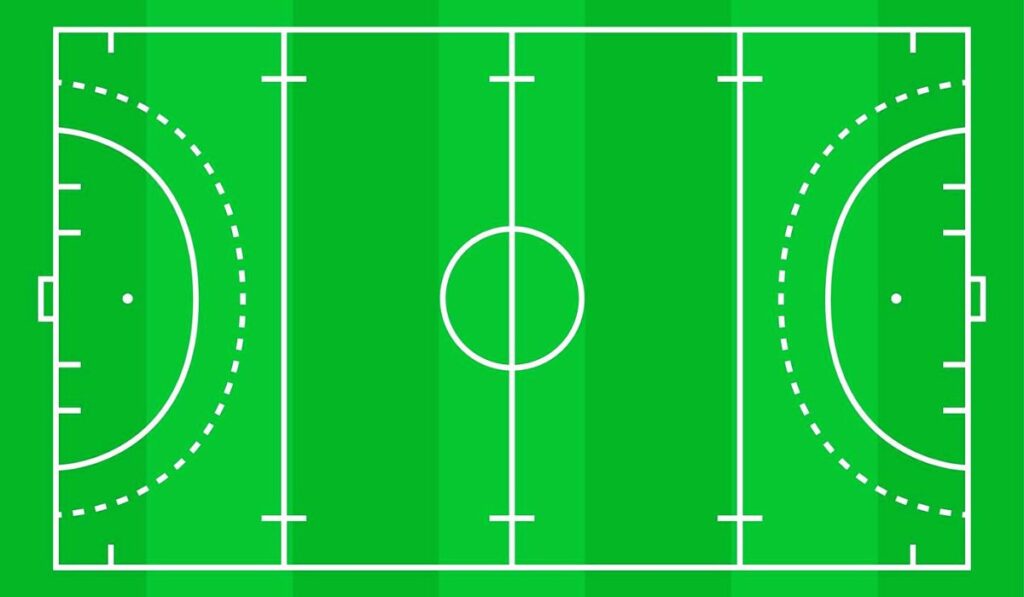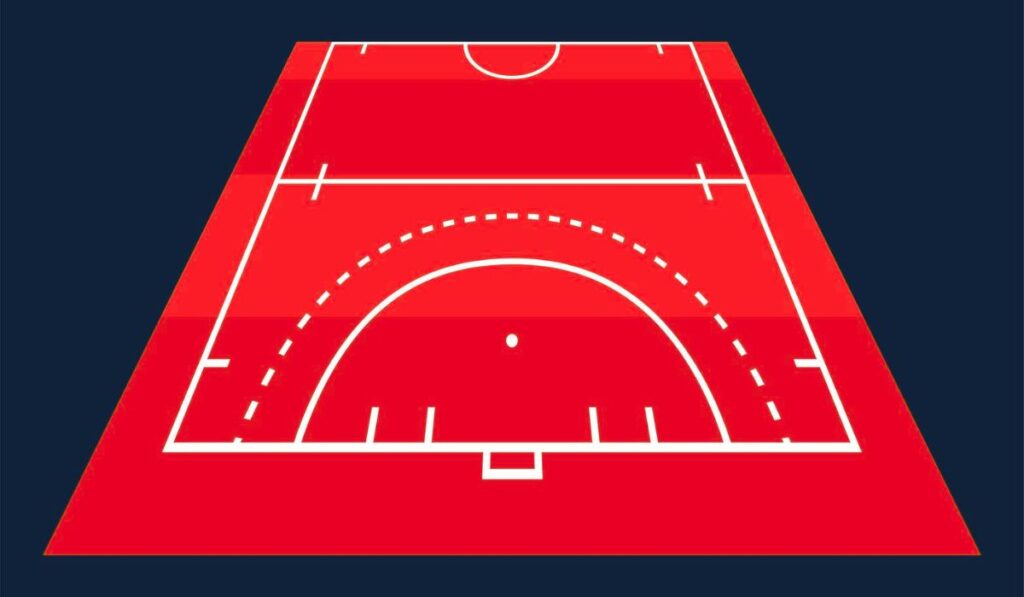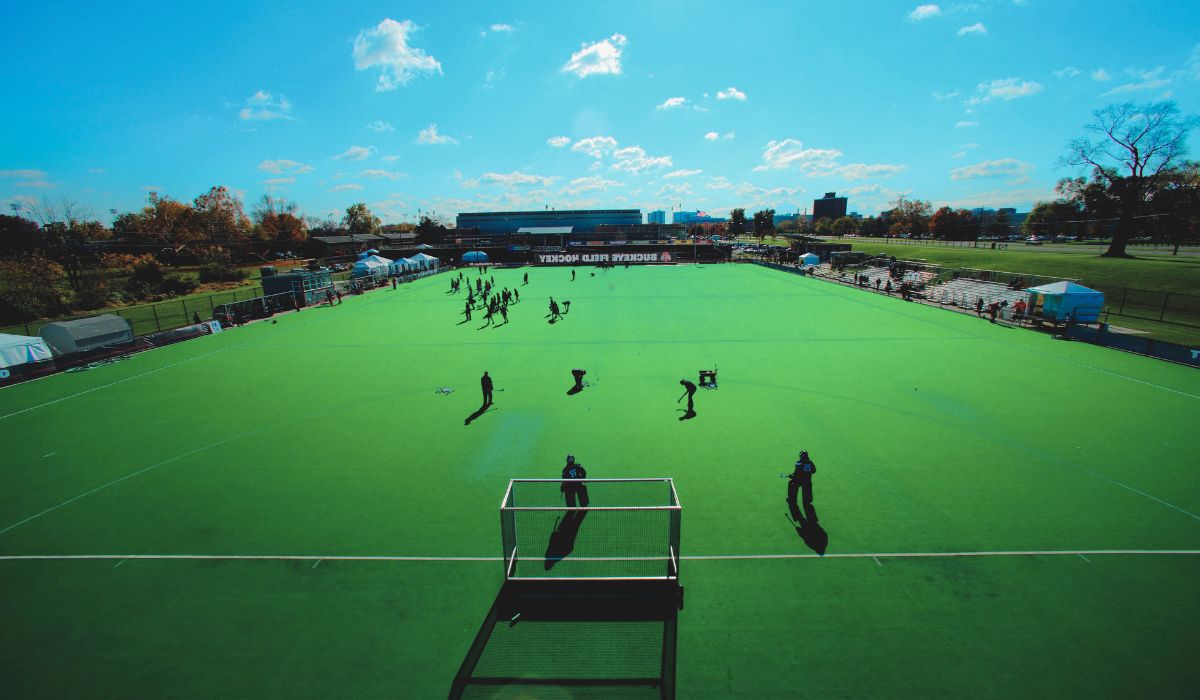When you first step onto a hockey field, the size can feel deceptive—spacious, intimidating, exciting. Official hockey ground size may seem standard—91.4 m by 55 m—but the way the turf feels underfoot, how your lungs expand when sprinting from goal to 23‑metre line, and how far that final pass seems to travel—all amplify the sense of scale. The physical dimensions may be fixed, but the thermal sensation, fatigue, and psychological stretch vary widely depending what you’re wearing, the weather, and your fitness.
Balancing Speed and Cover in Hockey Dimensions
At regulation size, the field demands a careful balance between sprinting ability and spatial awareness. A player might sprint full speed for the first 20 m, then slow as blood surges in their veins. The hockey ground size puts endurance to test—once the tilt shifts toward slower pace, tactical awareness takes over. It’s not just about how fast you can run, but how you position yourself in that space when the pace drains out. The field doesn’t just demand speed; it demands stamina and strategic insight.
How Standard Size Impacts Tactical Play
In a match, a wide-open hockey pitch allows for more expansive attacking play—wingers stretching the play, midfielders switching zones. Conversely, narrow or modified formats compress that room. Knowing the hockey ground size helps captains plan overlaps, critical passes, and pressing traps. The knowledge that your goal circle sits 5 m from baseline, or the 23‑metre line sits at about 3 m depth from the end, becomes vital tactical information. Even knowing the exact length of the court gives a subconscious advantage in anticipating space.

How Hockey Fields Vary Across Levels
Not all matches use the full 91.4 × 55 m. For youth levels or local leagues, fields are often scaled down—perhaps 70 m by 50 m—to match fitness and attention spans. That truncation changes effort perception—half the pitch feels just as long when you’re pacing players aged seven to twelve. When stepping up to full hockey ground size in senior play, understanding the additional ground to cover is a mental and physical shockwave. Training intensity and endurance drills must ramp up to meet the leap in scale.
The Emotional Shift When Field Size Expands
There’s a subtle emotion when transitioning from youth or indoor play to open outdoor fields. When players cross the full field for the first time, they often talk about feeling “small”, “exposed”, or “in awe”. The breeze at 55 m width, the sightlines across to the goal at 91 m—it becomes emotionally majestic, overwhelming, or intoxicating depending on your mindset. New players feel vulnerable, while veterans feel energized. That shift in perception is intimately tied to the hockey ground size pushing you beyond comfort.
Why Surface Type Modifies Perception of Size
An artificial turf rink plays faster than grass. Every pass and dribble glides further. On grass, ball movement is slower, so ground feels heavier—and each 5 m chunk feels physically and mentally longer. Even though dimensions don’t change, how players perceive space does. A hockey ground size felt easy to cover on turf can suddenly feel like a struggle on grass. Training must account for this sensory difference, or players risk underestimating the field by assuming their pace translates equally across surfaces.
How Ground Size Influences Game Strategy
Coaches often design defence zones based on ground size. A standard field is divided mentally into thirds—attacking, midfield, defensive. But if the pitch is shorter or narrower, the distribution changes. Goals come quicker, defending becomes compressed. Knowing the exact hockey ground size lets teams plan counter-presses, switches, or long hits more precisely. It determines where to apply pressure, when to sit back, and how to exploit half spaces. It shapes the heartbeat of strategy.
Training Smart for Full-Sized Fields
Working on speed endurance, sprint repeats, and streamlined movement is essential for handling the full hockey ground size. Drills like earning 30 m sprint followed by lateral shuffles and shot practice mimic the energy transition that field demands. Without purpose-built training, players arriving at full-size fields for the first time often gas out by the 60th minute. Conditioning must scale with pitch size—not just days before, but over weeks in preparation for matches.
How Branding and Field Markings Guide Play
Lines on the pitch—particularly the 23 m arc, the goal circle, the penalty spot—are key visual markers. They transform the hockey ground size into zones of threat, retreat, and opportunity. Hover too far inside your own 23 m, and interceptions become harder. Hover close enough, and you’re threatening space. Those painted lines help players feel the pitch. They become mental boundaries that shape tactics and positioning. Missing those cues on oversized or reduced pitches causes confusion—understanding the geometry changes everything.
The 23-Metre Line: A Subtle Divider with Major Impact
Among the most influential markings on a standard hockey ground is the 23-metre line. While it’s just a line on paper, its presence divides the field into critical tactical zones. For defenders, it signals a need to tighten structure and avoid fouls. For attackers, crossing into this zone unlocks specific set play opportunities like free hits that can lead to goal-scoring chances. On a full hockey ground size, this line becomes a battlefield of tension and energy. Teams that understand how to dominate this space often control the match tempo.
Emotional Toll of Playing End-to-End on a Regulation Field
The emotional side of hockey often goes unnoticed, yet the ground’s scale plays a psychological role. When you’re pushing forward at full tilt only to have the play reversed seconds later, that 91.4 metres feels brutal. Fatigue blends with frustration. You’re gasping, your calves are burning, and mentally you’re chasing two plays behind. The hockey ground size can feel punishing when momentum is lost. But flip the situation—win back possession, launch a counterattack—and suddenly that same length becomes exhilarating, full of possibility.
How the Goal Circle Changes Game Dynamics
The goal circle, also known as the shooting circle or “D”, spans a 14.63-metre radius around the goal. This semicircular area controls where shots on goal are legal, adding a layer of precision to offensive strategy. Players must enter this arc to take a valid shot, requiring perfect timing and positioning. On a full hockey ground size, this circle becomes a pressure cooker—packed with defenders, goalkeepers, and attackers trying to claim precious space. It’s a high-stakes zone that often decides the match outcome.
Penalty Corner Setups and Ground Proportions
Penalty corners, also called short corners, are moments where the ground’s dimensions become a chessboard. From the baseline to the top of the shooting circle, players must execute tightly timed moves in a matter of seconds. The injector, trapper, and hitter operate with ruthless precision, often with opposing defenders rushing from the goal line. On full hockey ground size, practicing these routines repeatedly becomes essential. Even a few inches off position can mean the difference between a goal and a deflection wide.
The Impact of Sidelines on Passing Width
Wide, flat passes that switch the play across the width of the field can break down a tight defense. The 55-metre width in a regulation Hockey Ground Size gives players room to exploit space on the wings. Teams that train to use these sidelines effectively often stretch defensive structures and isolate opponents. This width also challenges defenders to track runners and maintain line integrity. A poorly executed pass or misjudged angle leads to turnovers, often resulting in counterattacks through the middle.
Goalkeeper Experience on a Full-Sized Pitch
For goalkeepers, field size changes everything. On a smaller pitch, play reaches them faster but with less spacing for attackers to maneuver. On a full-size field, however, shooters can line up powerful hits from angles that require sharp reflexes and perfect footwork. The 7.32-metre-wide goal mouth feels larger when attackers are closing in from either wing. Positioning becomes more dynamic. Reading angles from 20 metres out is different than reacting to shots from within 5. The hockey ground size demands more than just reflexes—it requires anticipation.
How Field Size Affects Team Formations
Team formations are often built around the pitch dimensions. On a full-size field, you’ll see more structured systems like 4-3-3 or 3-4-3, allowing players to cover width and length more effectively. In contrast, smaller fields push teams toward compactness. Understanding the layout of the hockey ground size lets coaches choose when to press high, sit deep, or transition quickly. Formation flexibility is often the hidden edge between equally skilled teams—adapting to the space creates mismatches and advantages.
The Sound and Feel of the Ball on Turf vs. Grass
On artificial turf, the ball glides. Every push or hit makes a satisfying skimming sound that can be heard from the sidelines. On grass, it’s duller, heavier—each pass has to be stronger, more deliberate. These small sensory differences change how players interact with the field. The hockey ground size feels longer on grass because movement is slower, while on turf the game is faster but more tiring due to constant motion. Sensory memory plays a role: players train their ears, eyes, and feet to recognize field feel.
Heat and Weather’s Role in Perceived Pitch Size
Weather subtly alters the perception of the field. On humid afternoons, the turf feels stickier underfoot, and every sprint drains more from the lungs. On cold mornings, the ground hardens, and impacts sting a little more. Even the sun’s position affects visibility and perception of distance. A full hockey ground size under midday sun feels far less inviting than the same field under clouds. Coaches often rotate benches and game plans to compensate, knowing weather shifts impact how large the field feels.
Learning to Master Spatial Awareness
One of the most underrated skills in hockey is spatial awareness. Knowing where you are on the field, and where others are without looking, comes with time and repetition. On a smaller pitch, it’s easier to develop this instinct. But on a full hockey ground size, the stakes are higher. One misjudged position can open lanes for opponents. Great players can “feel” the field—how much time they have, where space will open next. It’s not magic. It’s muscle memory built on the rhythm of real-sized grounds.
Designing Drills Around the Full Hockey Ground Size
When coaches design drills, the size of the field directly influences the type of training. On a smaller pitch, drills are rapid, tight, and focused on close control. But on a regulation hockey ground size, there’s room to simulate real-match conditions—switching play from one wing to another, setting up counterattacks, or working on deep defensive lines. These drills stretch player awareness, build endurance, and promote real-time decision-making. The size also teaches athletes to adapt spacing, understand angles, and communicate more efficiently over distance.
Building Stamina on Regulation-Sized Fields
Fitness is fundamental to success in hockey, and the size of the pitch plays a silent but dominant role in shaping physical readiness. On a standard hockey ground size, players are expected to sprint, recover, and sprint again across nearly 100 metres—often multiple times within a minute. Unlike confined futsal-style play, there’s no rest in the corners. Midfielders, in particular, cover immense distances, linking attack and defense. As a result, fitness programs now include endurance runs, shuttle sprints, and interval work tailored to field proportions.
Spatial Memory: Knowing the Ground Without Looking
Top-level players develop something called spatial memory—the ability to know their place on the field without constantly checking. On a full hockey ground size, this skill is vital. There’s no time to glance up at every move, especially when the ball is moving fast. Players learn to calculate positions based on instinct, past training, and patterns of play. When a winger cuts in, the striker knows where the ball is likely to arrive. When a midfielder scans the field, they’re seeing not just players but lanes and future opportunities.
Adapting Strategy to Half-Pitch vs. Full-Pitch Matches
Training or playing on a half-pitch vs. full-pitch can shape very different strategic mindsets. In a compressed space, pressure is constant, and decisions must be made instantly. But on a full hockey ground size, strategy becomes layered. A team might defend deep and rely on long aerial passes. Others might press aggressively using the entire width to spread play. Understanding how different formations expand or contract based on field size is what separates average teams from those that dominate. The pitch isn’t just a stage—it’s a canvas for tactical art.
Psychological Pressure Created by Open Space
Large, open spaces create more than tactical problems—they produce mental challenges. A young player standing alone on the right wing of a full-size field might feel isolated, unsure, or exposed. The same player on a smaller pitch may feel constantly involved. Coaches recognize this and often assign roles or responsibilities to help players stay mentally locked in across all zones. The full hockey ground size tests not just lungs and legs, but mindset. Knowing how to handle space mentally is as important as being able to use it physically.

Artificial Turf vs. Natural Grass: Size Perception Shift
While the field’s dimensions remain the same on paper, the experience of playing on turf versus natural grass is dramatically different. On artificial turf, the ball moves faster, play becomes quicker, and the hockey ground size often feels smaller because transitions happen so rapidly. On natural grass, especially when slightly overgrown or wet, the field can feel heavy and laborious. Each surface presents a different rhythm. Coaches must plan differently, and players must adjust their touches, timing, and energy expenditure accordingly.
Transition Play: Covering Ground from Defense to Attack
One of the most breathtaking elements of modern hockey is the speed of transition—from defending a penalty corner to launching a blistering counterattack in seconds. This movement covers huge distances and would be impossible without mastering how to use the full hockey ground size. Transition play requires anticipation, communication, and high fitness. It also demands spatial awareness, as players must run into space, not just toward the ball. Teams that thrive in transitions are often those who understand how to manipulate the pitch’s dimensions to their advantage.
Teaching Young Players the Language of Space
For beginners or youth players, the full size of a hockey ground can feel intimidating. Teaching them isn’t just about stick skills; it’s about showing them how to use space. Coaches often break the field into zones—left wing, right channel, centre corridor—to give young athletes spatial references. Once kids start seeing the field in terms of options and zones rather than just chasing the ball, their game elevates. The regulation hockey ground size becomes a living, moving puzzle they learn to solve in real time.
Choosing the Right Field Size for Skill Development
Youth academies and local clubs should think long-term. Rather than pushing kids onto full-size fields too early, they should match the hockey ground size to their fitness and focus capacity. A 70 × 50 m pitch is ideal for teaching passing and pattern play without overtaxing legs. As players mature, gradually scale to the full size. That structured exposure builds competence and endurance without overwhelming young bodies—laying the foundation for smoother transitions later.


1 thought on “Why Hockey Ground Size Feels Larger Than Numbers”